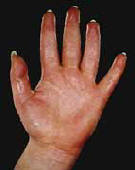What is Hyperhidrosis (Hyperhydrosis) or excessive sweating
 Hyperhidrosis is a disorder characterized by excessive sweating that occurs in up to 1% of the population. The excessive sweating can occur in the hands (Palmar hyperhidrosis), in the armpits (axillaries hyperhidrosis), or in the feet (plantar hyperhidrosis). Although nobody understands the exact cause of this excessive sweating in specific individuals, it is known that the sweating is controlled by the sympathetic nervous system.
Hyperhidrosis is a disorder characterized by excessive sweating that occurs in up to 1% of the population. The excessive sweating can occur in the hands (Palmar hyperhidrosis), in the armpits (axillaries hyperhidrosis), or in the feet (plantar hyperhidrosis). Although nobody understands the exact cause of this excessive sweating in specific individuals, it is known that the sweating is controlled by the sympathetic nervous system.
What is the sympathetic nervous system?
The human body possesses two different sets of nerves: the somatic nervous system and the autonomic system. The somatic nervous system is the system of voluntary nerves that give us sensation (pain, heat, and touch) as well as the control of our muscles that allow us to move the different portions of our body at will. The autonomic nervous system, on the other hand, is the involuntary nervous system. Many of our bodily functions occur without conscious control such as the rate at which we breathe, the beating of our heart, and the production of sweat, which is important for regulating body temperature. The autonomic nervous system is made up of two components: the sympathetic and the parasympathetic systems. It is the sympathetic nervous system that controls the sweating throughout our bodies.
What causes the sympathetic system to malfunction?
Although there is ongoing research investigating this abnormality, it is not known what specific defect occurs that results in excessive sweating. Whether it is the over activity of the sympathetic nervous chain or the sweat glands themselves is uncertain.
What are the symptoms of excessive sweat or hyperhidrosis?
Patients with hyperhidrosis have excessive sweating that hampers their activities of daily living. It is sometimes brought on by stress, emotion, or exercise, but can also occur spontaneously. Patients with
Palmar hyperhidrosis have wet, moist hands that sometimes interfere with grasping objects. Most patients with
Palmar hyperhidrosis also consider it a difficult social problem since every time they shake hands, they leave the other person's palm very moist, a sensation most people find unpleasant. Those who suffer from axillary hyperhidrosis sweat profusely from their underarms causing them to stain their clothes shortly after they dress. Once again, this proves to be very unsightly and a social disadvantage. Plantar hyperhidrosis is the excessive sweating of the feet and leads to moist socks and shoes as well as increased foot
odour.
What is the treatment for hyperhidrosis?
The initial treatment for hyperhidrosis is usually medical and does not involve surgery. There are ointments and salves available (i.e., Drysol) that are astringents that tend to dry up the sweat glands. Another treatment is iontophoresis. This consists of a treatment of electrical stimulation, usually in the hands. Patients place their hands in a bath through which an electrical current is passed. This treatment tends to "stun" the sweat glands and can decrease the secretion of sweat for periods of 6 hours to one week. One of the most recent treatments proposed is the injection of botulinum toxin (Botox) into the area of excessive sweating. This is a toxin that affects nerve endings and decreases the transmission of the nerve impulses to the sweat glands thus resulting in decreased sweating. It generally requires several injections in the palms or underarms and it remains effective from one to six months. Repeated injections are nearly always required to maintain an adequate level of dryness.
In addition to the above treatments, many medicines have been utilized with varying success. These include both sedatives (in those patients with stress-induced hyperhidrosis) and medications that affect the nervous system. A family practitioner or internist often begins the initial treatment for hyperhidrosis. Cases not responding to simple treatment regimens are often then referred to a specialist such as a dermatologist or neurologist. In general, surgery is contemplated only when the less invasive medical treatments have failed to provide adequate treatment
To this date, electronic Iontophoresis treatment appears to be the best treatment, suited for the most patients, with the least side effects, plus the longest remission period without drugs or surgery.
 Everyday our bodies naturally perspire or sweat as a way to regulate our body temperature. Some people experience excessive perspiration or excessive sweat particularly in the face and hands. This condition is known as Hyperhidrosis (American spelling) or Hyperhydrosis (European spelling) and is defined as the production of perspiration beyond what is necessary to cool the body. Everyday our bodies naturally perspire or sweat as a way to regulate our body temperature. Some people experience excessive perspiration or excessive sweat particularly in the face and hands. This condition is known as Hyperhidrosis (American spelling) or Hyperhydrosis (European spelling) and is defined as the production of perspiration beyond what is necessary to cool the body.
Excessive sweating, or Hyperhidrosis (Hyperhydrosis,) is a medical condition that can be devastating. Excessive sweating all day everyday can be awkward
embarrassing and annoying. Not to mention the health implications of sweating excessively. A person with excessive sweat will typically attempt to disguise the excessive sweating with clothing, powders, and pads - however this is often unsuccessful. |